Just What Makes 'Mortal Kombat' so Special?
Come with me on a journey through its legacy.
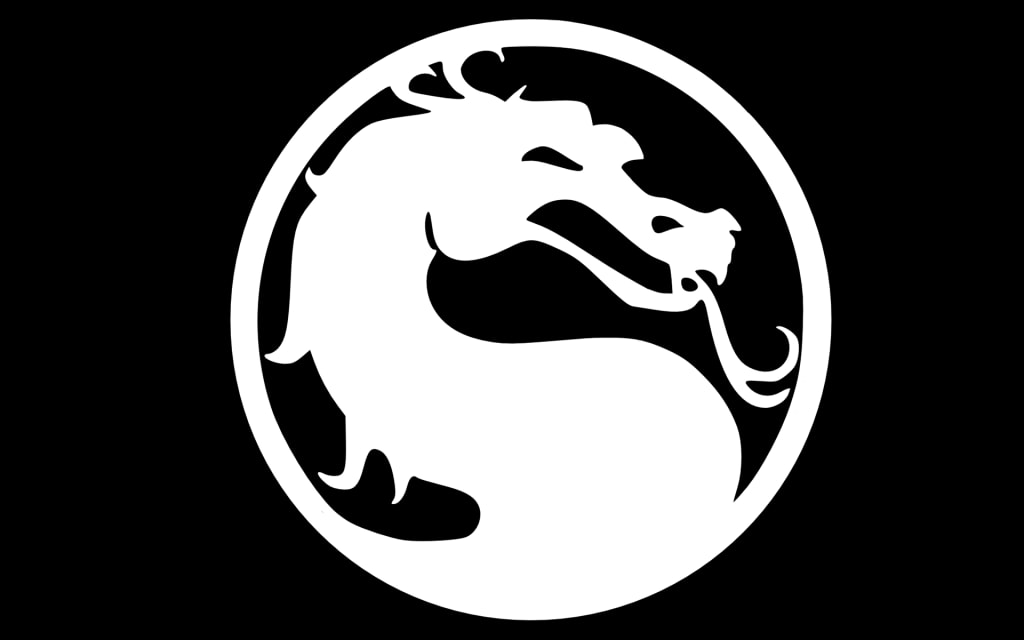
Back in 1992, Mortal Kombat hit the scene so hard it straight up decapitated it and ensured that Kombat with a K would be remembered forever. That's not to say the series is without some serious missteps, but unlike Sonic the Hedgehog, there's no question as to why Mortal Kombat has endured to this day. As co-creator, John Tobias, once said, “It'll be around 50 years from now.” Tobias might not be attached to the property any more, but he's still right. If you'll stay and read a moment, I'd like to outline just what makes this bloody game so bloody special.
At first blush, it's very easy to see what made Mortal Kombat stand out from its primary competitors, Street Fighter II and Fatal Fury. Besides the digitized sprites and the introduction of a separate block button, there was the blood. Oh, was there ever blood. I still have the distinct memory of standing in a Godfather's Pizza, awaiting that delicious golden crust, when I watched Sub-Zero grip Scorpion by the neck and pull, ripping his head from his shoulders. Scorpion's newly exposed spinal cord dangled limply and I was entranced. Blood dripped into a pool on the floor and I ran to my parents to get some quarters of my own. I wanted to witness what else this game had to offer.
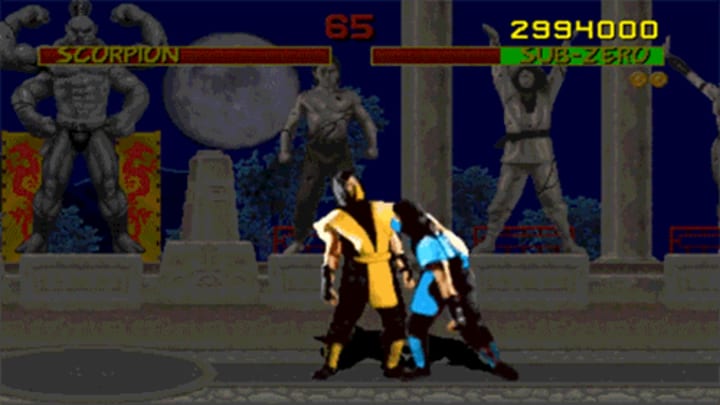
Sub-Zero won the fight and the hearts of children everywhere.
That kind of reaction from children my age and even younger did not go unnoticed. Parent groups and government officials wanting easy explanations for misbehaving kids jumped on Mortal Kombat and its extreme violence. Along with other titles like DOOM and Night Trap, Mortal Kombat has the distinct privilege of being a video game singled out by name as a reason for the establishment of the Entertainment Rating Software Board (ESRB). Like television and rock and roll before them, video games had been demonized by old white men and Mortal Kombat was one of the first to get that public finger wagging.

No wonder politicians were so worried about children getting their hands on this game.
However, as with any other form of media, once someone is made famous for being controversial, everyone else wants on the bandwagon. Terrible Mortal Kombat clones like Tattoo Assassins or Time Killers popped up with promises of more blood and more finishing moves than Mortal Kombat could offer you. What they failed to realize, though, is that Mortal Kombat had more than just the dripping word, “Fatality.”

To its credit, Eternal Champions put a lot of care and effort into its horrific death scenes.
Even as far back as the first in the series, Mortal Kombat already stirred up schoolyard rumors. It started with real things like sound designer, Dan Forden, popping up to shout his infamous, “Toasty!” or the then-unprecedented secret fight against Reptile. The secret code to unlock blood on the Sega Genesis release was spread from friend to friend and with it, even more rumors popped up. Maybe there was another hidden character named Ermac? Maybe you could fight that Toasty guy? All it took was a handful of mysteries or things the developers just thought would be fun and suddenly the sky was the limits.
That's what separates Mortal Kombat from the crowd. Yes, you can rip the still beating heart out of your opponent's chest, but what if you knew more than just how to perform that Fatality? What if you could show off a never-before-seen fighter to your friends? That desire to be cool and be in the know really drove Mortal Kombat's early life and is still alive today.

That's amore.
By the next year, 1993, Mortal Kombat II hit the scene and it completely doubled down on everything that made the first game what it was. Exciting new faces joined the fight, every character now had two Fatalities, new styles of finishers let people show off their knowledge, and even more hidden characters dropped hints at their existences. At the time, Mortal Kombat II wasn't just fun to play. It also seemed like a bottomless well of secrets and experiences. Even if it wasn't, people were quickly turning it into one.
Friendships and Babalities weren't enough. Nudalities and Animalities were invented and claimed to have been seen in arcades. Smoke, Jade, and Noob Saibot (named for series creators Ed Boon and John Tobias) weren't enough. Ermac was still rumored and Skarlet was invented to be his female counterpart. The arcade machine's debug menu listed Kano transformations and Shawn Attacks as statistics despite Kano not being playable and there still hasn't been an explanation for Shawn Attacks to this day. Midway had just enough secrets actually in the game that people would be stuck on the wild goose chases after everything else was discovered for years to come. There was a certain kind of magic surrounding Mortal Kombat II that could not be repeated.
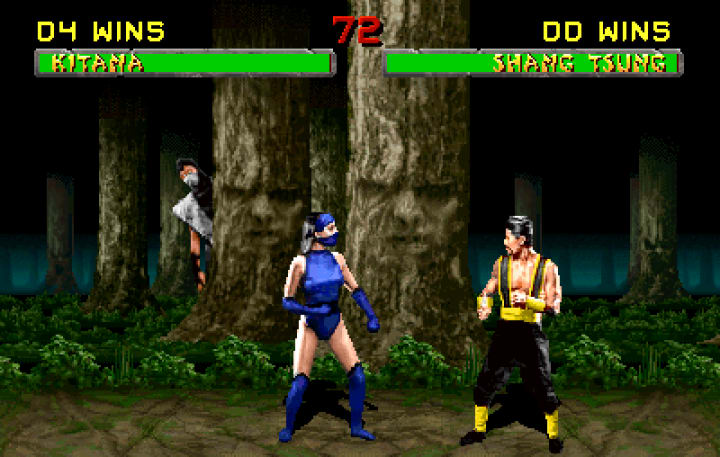
"Can I play too?"
That's not to say Midway wouldn't attempt it in 1995. Shao Kahn returned in Mortal Kombat 3 to avenge his previous tournament loss and was bringing his newly resurrected wife, Sindel, with him. Unfortunately, a lot of favorite faces from MK2 did not return. Kitana, Mileena, Reptile, and even Raiden, for example, were all mysteriously missing after being fan favorites after their introductions. However, strangest of all, was the fact that poster boy Scorpion just sat this fight out until the updated release of Ultimate Mortal Kombat 3 which also brought back the missing cast as well as introducing Jade as a playable character. A later release, Mortal Kombat Trilogy, made sure that every character from Mortal Kombat history was included to appease everyone.
As you might imagine, that gave the highly anticipated MK3 a false start at release, forcing fans to wait a full year for the definitive version of the game. That's not to say it didn't carry with it its trademark charm, of course. The secrets were still there, including Smoke and Noob Saibot as unlockable fighters, a new ninja named Rain that only appeared in the attract mode in arcades (he was only playable in home console releases), and Animalities actually existing after their rumors in MK2.
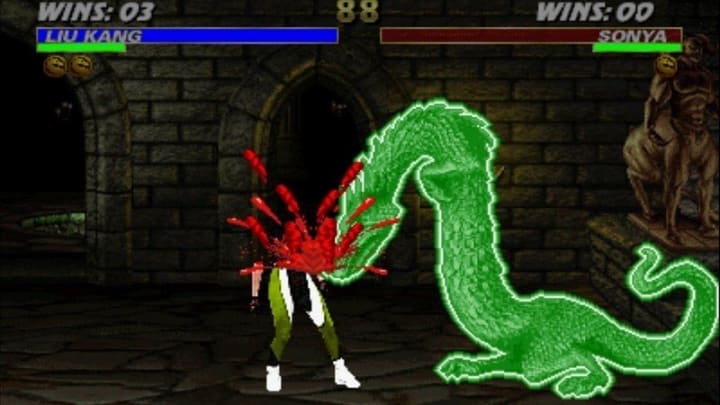
Liu Kang's dragon transformation doubles as a night light.
However, some of the charm was running thin in other areas. The quality seen in MK2 didn't carry over into MK3. Those Animalities had glowing, single color animals appear instead of well rendered beasts and some were things like penguins laying exploding eggs or vicious bunny rabbits a la Monty Python. If someone was cut in half, their sprite was literally just cut in half and their forearms would float in midair. Please note that this did not happen in MK2. Perhaps craziest of all was the amount of femurs the human body would contain. In any Fatality causing the victim to explode, it was not uncommon to see three arms, two skulls, and 18 femurs raining down as if to suggest the developers got tired at this point and just didn't care any more.

That's an appropriate number of skulls and arms, sure.
They cared enough to try some new things like Brutalities, Mercy, and a run button, but it all felt phoned in this time around. That's not to say the game wasn't still fun, but when a kool, new kombatant like Kabal's Fatalities consist of either inflating your head like a balloon or scaring the ghost out of you with a spooky face, the hokey nonsense gets to be a bit much. Mortal Kombat has always walked the line between grim, disturbing violence and funny, ridiculous violence, but MK3 took too far of a step into the silly camp for a lot of fans.
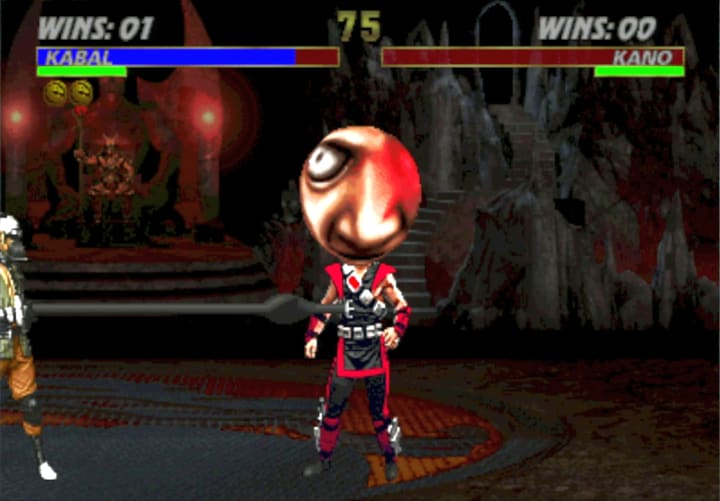
I've had colds that made me feel like this.
There was one thing that helped smooth things over, though. It was something only Mortal Kombat could achieve at that time and that was a movie based on a video game that didn't completely suck. In the same year as MK3's initial release, the Mortal Kombat movie hit theaters along with that iconic theme song. The movie was so successful, it actually influenced the games, essentially making Kano who he is today with his Australian accent. By today's standards, it might not hold up as well, but anyone who was a Mortal Kombat fan in the mid-90s was blown away, particularly after the previous year's laughably abysmal Street Fighter movie which was only propped up by the late, great Raul Julia playing himself playing Gomez Addams playing M. Bison.

Johnny Cage wonders if Goro has four nuts to punch too.
What I'm saying is that Mortal Kombat is such a phenomenon, that even in the face of a sequel that didn't quite achieve the feel of the previous game, it could still spawn a fun, enjoyable movie that kept Mortal Kombat alive in the hearts of its fans. Granted, it also spawned Mortal Kombat: The Journey Begins in 1995, but the less said about that, the better.
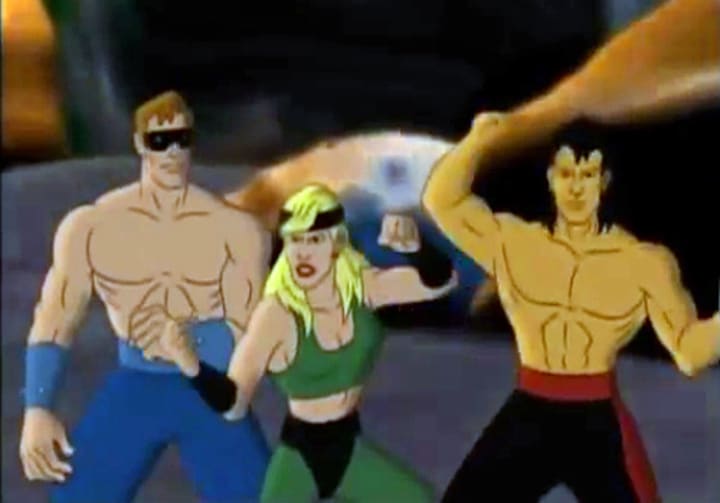
This art is still somehow better than the CGI sections.
Actually, maybe bringing that up is a valuable point. Mortal Kombat isn't immune to awful garbage. It isn't some stellar property that has never been down on its luck or never seen a bad day. Perhaps that's part of the magic. It's sometimes amazing and impressive but sometimes it's trash and I think that makes it more relatable and accessible. We all go through the same transformations ourselves. Even Mortal Kombat had its weird puberty stages and brain-dead slip ups like any one of us. That leads me now to the most awkward year of Mortal Kombat's life and it was 1997.
The first stage was Mortal Kombat Mythologies: Sub-Zero in August of that year. It was named as if other Mythologies games would possibly follow and gave players a look into Mortal Kombat's lore stretching back to even before the first game. It also played like a fighting game got into a car crash with a side scrolling beat-em-up. It was stiff, difficult to play, and featured low budget, FMV cutscenes with live actors. While the full motion video had some real heart to it, that wasn't enough to hold the title up and most audiences shrugged the game off, saying it just felt outdated and clunky.
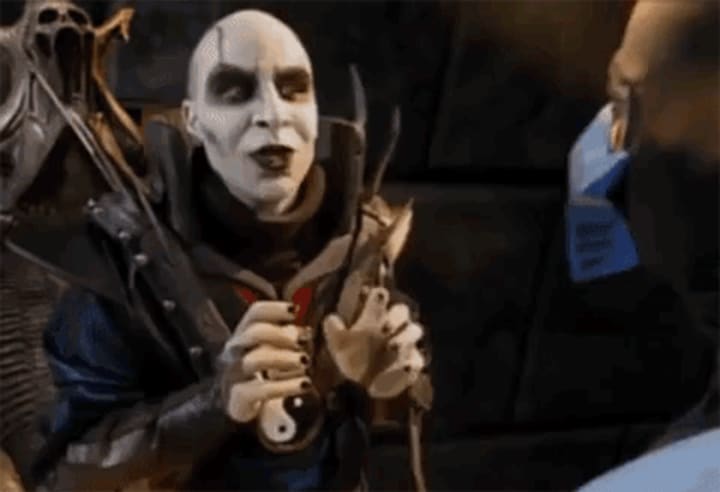
It was pretty Quan Cheesy.
Mortal Kombat 4 was what people were really waiting for and it released in October of '97. It promised a new way to play your favorite fighting game and shucked the digitized, 2D sprites in favor of polygons. Everyone else was jumping on the relatively new technology and, to keep up, Mortal Kombat had to as well, even if it meant losing the distinct, stylistic, photo-realistic actors in favor of graphics that honestly did not stack up to competitors like Tekken 3 or Soulcalibur. Concessions to technology like that were ultimately what kept MK4 from tasting success, but they can't get all the blame.
Once again, there were a couple missing faces from the roster, like Kitana, Mileena, and the cyborgs of MK3, but they would return with 1999's rerelease as Mortal Kombat Gold. The real roster problem was the new blood on the scene. Uninspired characters like Kai, Jarek, and Reiko really paved the way for the forgettable or even terrible cast of later Mortal Kombats. Fan favorite, Reptile, also became more reptilian and less human, much to the dismay of many who preferred his gimmick of concealing his true identity behind false flesh. To cap it all off, the voice acting took a swerve into insanity with combatants spouting complete gibberish and lines being read with some infamous results.

It would certainly be game over if Midway didn't make a change soon.
It's easy to see why, after a questionable presentation like that, the technological limitations were the final straw. Fatalities had to be simplified to accommodate 3D models instead of 2D sprites, forcing almost all of them to be simple decapitations or bisections. Midway did what they could to make them feel different, but the end results were by and large all the same. Polygons were just separated from each other with thick, ketchupy blood effects and the series staple finishing moves became extremely stale. In fact, this was the first time in the series that the trademark Mortal Kombat magic felt like it was missing.
The franchise made the jump to 3D, but Tekken and Virtua Fighter had already done that. The old graphical style was gone in favor of the same thing everyone else was doing. Secret characters existed, but there weren't any coy rumors lurking around this time (minus Belokk in regards to MK Gold who was confirmed to have just been scrapped). The new characters were nowhere near as interesting as the cyborgs or Sheeva. When even the Fatalities weren't fresh or new, there was nothing for fans to really grasp onto. It was official. Mortal Kombat hit a slump and it hit it pretty hard.
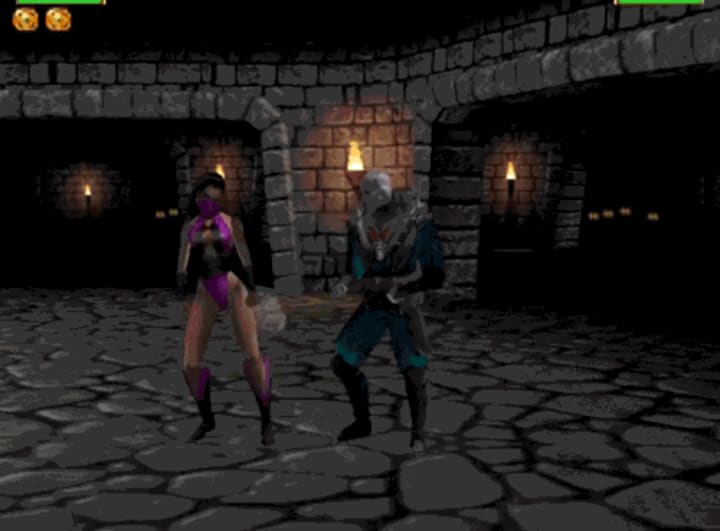
Shout outs to Quan Chi for having one outstanding Fatality, at least.
What helped even less was the sequel to their first, successful movie being one of the most memorable disappointments of my childhood. There was Ninja Turtles 3: Turtles in Time and then there was Mortal Kombat: Annihilation. MK:A, released the same year as the initial MK4, attempted to cram every character from the first three games into the movie, at least by dropping their names if nothing else, and had no regard for its script, proper character representation, the plot of the games, acting, action, or anything else it takes to make a movie. It remains as one of the worst cinematic experiences you could suffer through and, even as a child, I resented its very existence. I still do to this day.

At least Spirit Halloween made a few bucks.
With that double whammy, Midway needed to reclaim its former glory in a big way. I don't know what went on behind the scenes, but their solution was to hold back on making another standard fighting game and try their hands at going even further back in time with another story driven game like Mythologies.
Mortal Kombat: Special Forces promised to be a third person title starring Jax and Sonya as they squared off against Kano's Black Dragon clan. It would not make good on those promises, however, as development was delayed, became strained, and changes had to be made, such as canceling the N64 version and removing Sonya as a playable character all together. Perhaps the biggest stumbling block in the game's way was the departure of series co-creator, John Tobias.

Actual Footage of John Tobias and His Black Dragon Clan Leaving Midway. (1999, Colorized)
Despite rumors to the contrary, Tobias did not leave under duress. In interviews, he claims he had to make a decision when viewing the state of the industry at that time. Sony was soon to release their PlayStation 2 and Microsoft would be revealing the first Xbox soon after. His game was going to land at the end of a console's life and likely fail. Rather than miss that sweet spot of new technology, Tobias said his goodbyes and formed Studio Gigante where he tried his hand at developing a whole new fighting game.
Ed Boon, the other creator of Mortal Kombat, remained at Midway and he and his team took a good, hard look at the competition at the time as they, too, were about to give the world another fighting game. Needless to say, Special Forces was a complete disaster and is considered the worst video game with the Mortal Kombat title to date; released quietly and without fanfare. If they were going to revitalize the brand, they would have to do something amazing. So, did John Tobias make the right decision and show the world his new vision or did Ed Boon and Midway drag themselves out of the muck? Is it possible that both succeeded, creating a strong new rivalry between former partners?
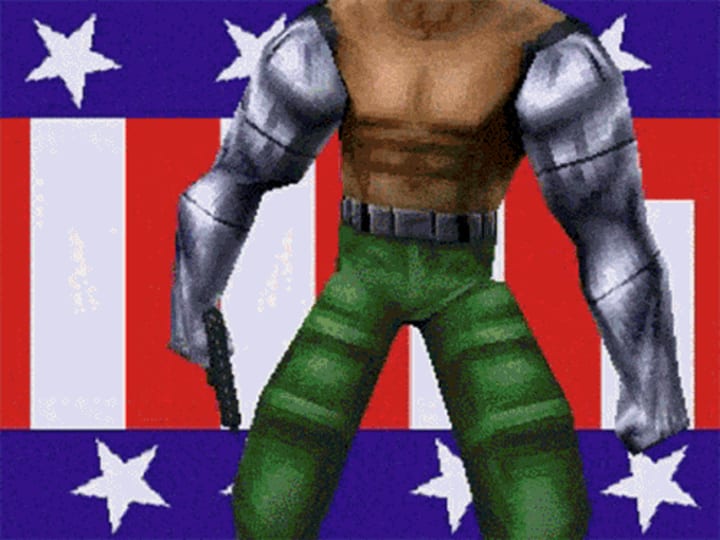
Jax looks for the man responsible for his terrible game.
In 2002, Mortal Kombat: Deadly Alliance showed the world that this franchise wasn't messing around. With better graphics, stance switching, and straight up murdering the main hero, Liu Kang, MK:DA made an impact. It was still a little janky, particularly in the animation department, and it introduced some really bad new characters, but it was such a massive improvement over MK4 that no one really cared. It also reintroduced that Mortal Kombat magic in the form of the new series staple: The Krypt.
By collecting Koins through playing the game or beating challenges, players could venture into a massive vault and spend their wealth on random prizes. Sometimes they would get new Fatalities, costumes, or even hidden characters... but sometimes you would just get concept art, clues to good prizes, or even nothing at all. It was a fun, exciting new addition that had people trading item locations online and even starting new rumors with things like the concept art for the joke character, Zebron. Mortal Kombat was back. Maybe it wasn't perfect, but it was back!
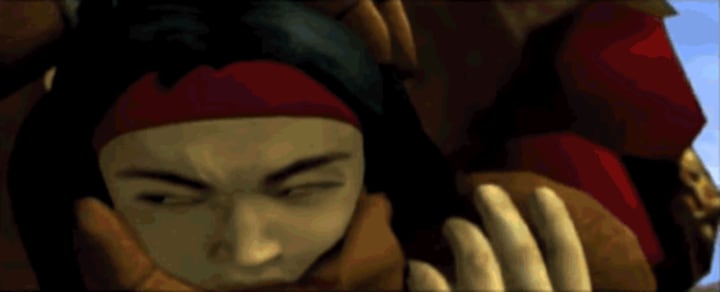
Sometimes, to save a franchise, you have to break a few eggs and a few necks.
Following closely in 2003, Studio Gigante's game, Tao Feng: Fist of the Lotus, was released. Unfortunately for John Tobias, the game featured completely uninspired characters, awkward combat, and the worst camera in fighting games. Critics panned the game, consumers rightfully ignored it, and Studio Gigante released a similarly rejected WWE Wrestlemania 21 before simply shutting down completely. While Ed Boon and John Tobias remain on good terms today, it's clear that creating Mortal Kombat doesn't give you that magic. The magic is contained within the game itself.

Tao Feng, A Game That Gives You Its Own Review.
Hoping to build on that magic was 2004's Mortal Kombat: Deception. The game itself was generally an improvement on MK:DA, but everything else around it was where the real Mortal Kombat flavor came through. Deception featured side games in the form of Chess Kombat and Puzzle Kombat, online fighting, Hara Kiris, the return of The Krypt, and a fully realized single player mode called Konquest. Even more interesting than the single player story, was what was happening with the story surrounding the cast as a whole. Liu Kang returned as a fighter, but now he was a reanimated zombie. No longer the hero of Earthrealm, Liu Kang was now just a humiliated corpse. Mortal Kombat has always followed its general storyline, but with Deadly Alliance and Deception, it was really starting to mean something and there was real continuity.

He retained his martial arts skills, but does he still know how to do the Thriller?
That's another certain touch that gives the series its magic. Mortal Kombat is set up in such a way that death means something but it doesn't mean that your favorite character won't return in the next game. Even if it does, that still doesn't mean it's permanent. It also doesn't mean they'll be the same as they were in the previous title. Deadly Alliance and Deception might be considered “bad” today, but they meant something very important.
It meant that people genuinely liked Mortal Kombat as a property. It wasn't just the games or the characters who weren't Hsu Hao, or the rumors and secrets; it was the culmination of everything. It was a special sauce that allowed them to once again make a non-fighting game in the form of Mortal Kombat: Shaolin Monks in 2005 but this time not screw it up. Maybe it wasn't the greatest game ever, but it was good and, more importantly, people loved it because it was Mortal Kombat and because it took people through the story of the beloved Mortal Kombat II.

I know now why you cry, but it's something I can never do.
So that was it. By now, Mortal Kombat was once again established as a household name, but there was a lot of chaff in its history. So much so, even Midway themselves recognized it. There were so many warriors and so many threats, all that power bloat was leading to Armageddon. Mortal Kombat: Armageddon, to be precise. In 2006, every single character ever made was thrown into a big mixing pot along with a cart racing minigame and the result was the largest rostered fighting game this side of Super Smash Bros. If you wanted to play as losers like Darrius or Mokap for some reason, they're here. You could even create your own fighter in this title, just to ensure no one was left out.
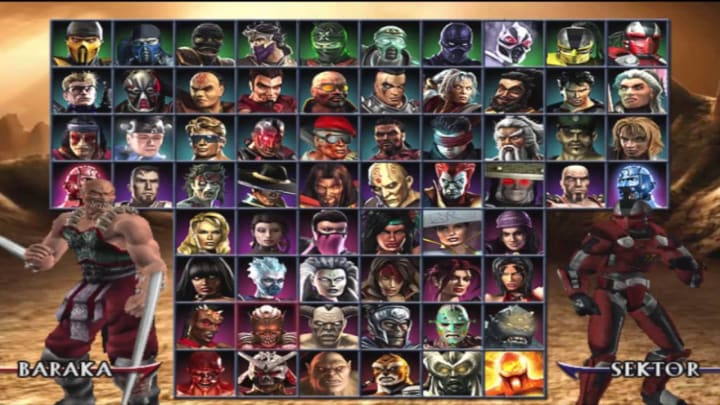
The gang's all here!
Sounds great, right? No, you're wrong. The focus on having every character involved left the game imbalanced and they were all subjected to the "Kreate a Fatality" mechanic, resulting in most everyone playing similarly and performing the same, anti-climactic finishing move at the end. Add to this that the big villain was Blaze, a generic, burning rock monster, and you have one very forgettable experience... except for one thing. The MK spark still glimmered to life in the best game intro of all time. Even when Mortal Kombat is bad, you just can't seem to hate it.

Stryker? Don't mind if I do!
In 2008, Midway would put that claim to the test with Mortal Kombat vs. DC Universe. If you ever wondered who would win in a fight between Sub-Zero and Batman, you need to get out more, but you could still get your answer. This game would feature a handful of popular icons from both universes forced to play guessing games and glowing yellow with anger. MK vs. DCU was generally poorly received for its clunky fighting and laughable, highly censored Fatalities. Being rated T for Teen, the once trademark gore of Mortal Kombat was abandoned for cartoony and underwhelming “Heroic Brutalities.”
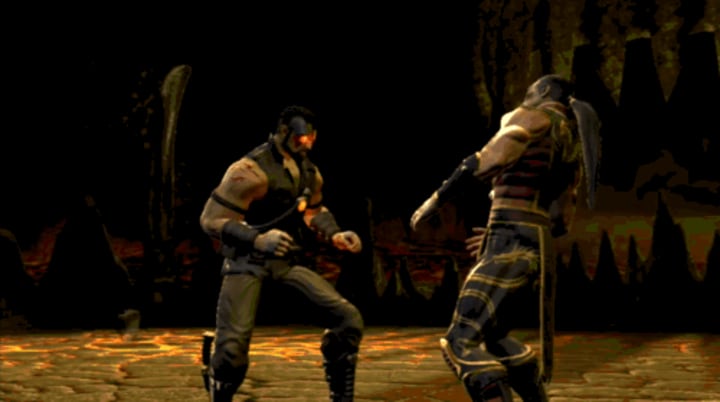
Absolutely Barbaric
That's not to say that nothing redeemed the game, however. The single player story mode was the first of its kind, driven by chapters specific to different characters as the entire saga unfolded. It was unique, particularly for a fighting game of all things, and would be seen again in the future. Not at Midway, however, as they would go defunct in 2010 and pieced up for buyers. The Chicago office, which was responsible for Mortal Kombat, was gobbled up by Warner Bros. Interactive Entertainment and rebranded as Netherrealm Studios.
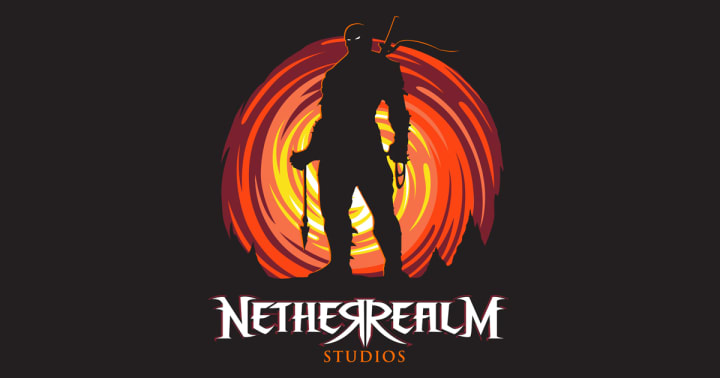
Liu Kang was never the face of Mortal Kombat anyway.
This proved to be one of the most important things to ever happen to Mortal Kombat. After a saga of seven mainline games, eight including the crossover with DC, the timeline ended in complete Armageddon. Bodies were strewn across the landscape and the realms had destroyed themselves. Where could the series go from there?
Like every franchise does eventually, we were going back in time. 2011's Mortal Kombat had no other title. It completely rebooted the series, in both its own universe and in ours, going through the timeline of the first three games all in one, and containing all the characters featured in those titles. As with MK vs. DCU, there was an epic single player story told through character specific chapters detailing how Raiden, during the events of Armageddon, sent a cryptic message to his past self in attempt to prevent such a dark future.

Unfortunately for Earthrealm, Raiden is an idiot.
In true Mortal Kombat fashion, the canon's continuity didn't end for the sake of a reboot. Everything we know about the previous eight games remains a possibility. Those entities and characters still exist to flesh out the universe. MK9, as it is known, didn't just play on nostalgia. It also continued the franchise.
It continued it in an incredible way, too. After the massive letdown of MK vs. DCU, we were treated to a return of the gore with new technology that allowed for fighters to get torn up and covered in blood, X-Ray attacks that should have been outright fatal on their own, and Mileena ripping off Johnny Cage's head to munch on it like corn on the cob. The brutal violence was back but so was the distinct fun and flair so core to the series. Challenge towers, minigames, and, of course, The Krypt all made an appearance. They even had the necessary secrets and rumors in the form of Cyber Sub-Zero, actually making the old whispers of Skarlet turn into an actual combatant, and giving players unlockable fights against Smoke and Jade, just like in the old days.
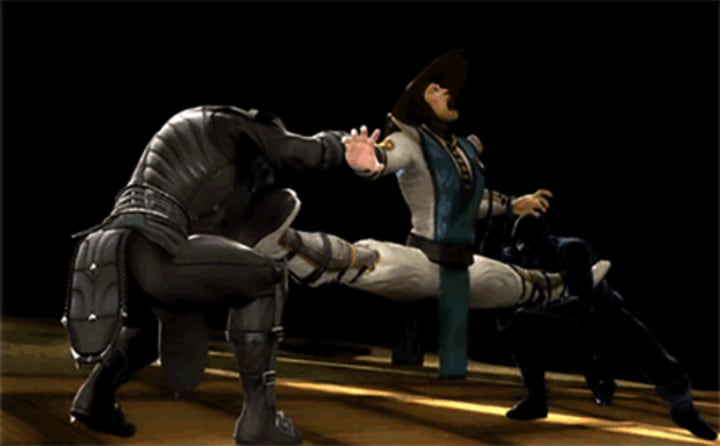
Make a wish!
Of course, in this new day and age, such secrets are impossible to keep with the advent of the internet. That doesn't mean the Mortal Kombat magic has turned stale, of course. Ed Boon has decided to use the internet to his advantage with a Twitter account full of hints, teases, trolling, and totally innocent posting that everyone interprets as the above. You can't data mine a tweet, and so throughout MK9's development, the game's DLC development, and beyond, fans flocked to Twitter to see what craziness Ed Boon would feed them next. It became an event with no semblance of a schedule.
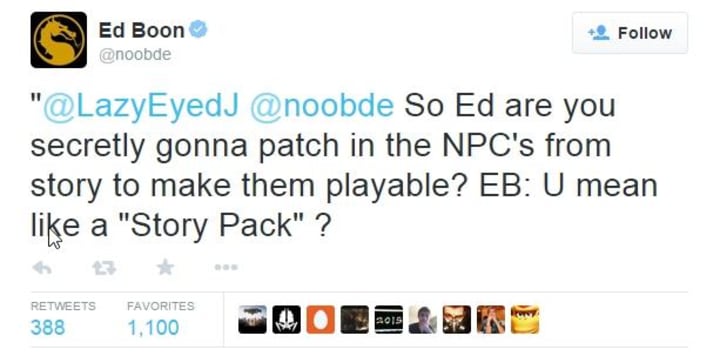
It never happened, but you never can tell what might. Just like the old days of Kano Transformations!
It has remained that way ever since. In 2015, Mortal Kombat X dropped and gave us Shinnok as the main villain, leaving us to presume that the timeline was now approximately what Mortal Kombat 4 would be if Raiden hadn't changed things up by bumbling around blindly throughout the retold events of Mortal Kombats 1-3. Characters were older and had children, new and cool warriors like Erron Black and D'Vorah showed up, and many things were turned on their head. Former heroes of Earthrealm were revenants under Quan Chi's control, former revenant Scorpion was returned to life and made peace with Sub-Zero, and former champions Liu Kang and Kitana are now king and queen of Netherrealm. Raiden screwed everything up and, with the defeat of Shinnok, seems to be turning dark and furiously proactive. Perhaps the rumored Mortal Kombat 11 will shed some light on that subject.
Though before we look to the future, we should look at Mortal Kombat X and what it did. It was the first Mortal Kombat past MK3 to add a roster full of new characters where, surprisingly, they were all good. Some might argue that characters like Jacqui Briggs or Kung Jin aren't overly interesting but they are a far cry better than the likes of Dairou or Kira. Of course, MKX even pulled Tremor out of MK: Special Forces and made him cool, so the new timeline of Mortal Kombat could work wonders on any of the forgotten fighters whether they were forgotten for a good reason or not. If people want to see a return of Ashrah or Hotaru, you can actually take them seriously. If Netherrealm can somehow make Bo' Rai Cho a half-way decent character, anything is within the realm of possibility.
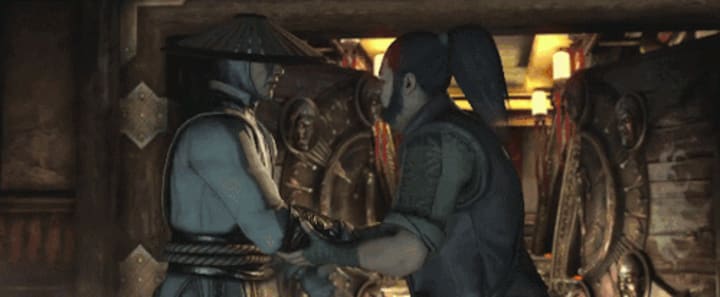
"Thanks for letting me leave the dumpster pile, Raiden."
Something Netherrealm Studios does, whether they're working on Mortal Kombat or Injustice, is put in a lot of care and effort; especially with guest characters. Even down to naming one of Jason's combos “Kill for Mother” or giving Kung Lao's chest-bursting alien baby a little hat, the small touches really go a long way. The characters also have unique interactions when stepping up to the battlefield, allowing them to interact and further flesh out the world. When Quan Chi casually tosses aside the severed head of Moloch or Erron Black offhandedly mentions he killed Kobra, it shows that the rest of the MK universe still exists, but we're focusing on the good parts.

Looks just like his mom.
By today, it should be clear just what makes Mortal Kombat so special. There is an enormous amount of care put into building the world, the characters within it, and the games themselves. Yes, there have been some laughably bad times, but since the series has endured, those times only serve to make the latest installments better. Nothing is forgotten, lessons are learned, and the polish is there. The series is something people can enjoy even if they don't like fighting games because of that.

Netherrealm knows how to pander.
There is a unique legacy to Mortal Kombat and it will most certainly be around forever. What started as kids making up rumors to be spread at school has become those same people trying to squeeze information out of Ed Boon on Twitter. What started as Johnny Cage just punching the head off Raiden's shoulders became Johnny Cage ripping through Kotal Kahn's torso while quoting The Shining. The feeling you had in 1992 is still there today. Just like you, the franchise has managed to maintain what it is and how it makes people feel without staying exactly the same. That excitement for a likely Mortal Kombat 11 on the horizon leads to the questions of who will be in it, how will the story progress, and how will everyone kill each other?
That's the beauty to Mortal Kombat. It's all about questions. Whether you're wondering how to unlock a secret, find an unlisted Brutality, perform a Fatality, or just what's causing Dan Forden to pop up, there always feels like there's something more to uncover. It's why fans have remained fans for over 25 years and aren't going to stop any time soon. Prepare yourself. Mortal Kombat is here to stay.
About the Creator
Suspicious Cook
Entertainment is important.

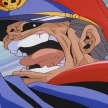
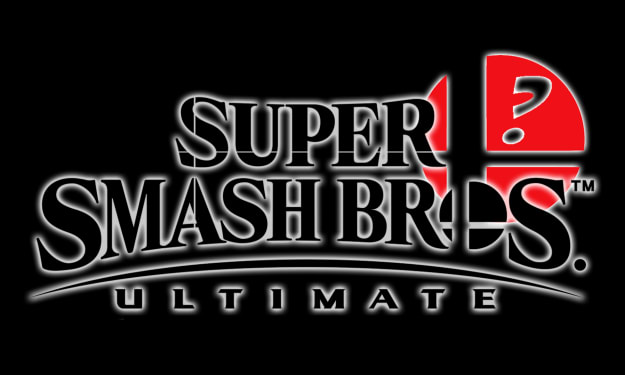

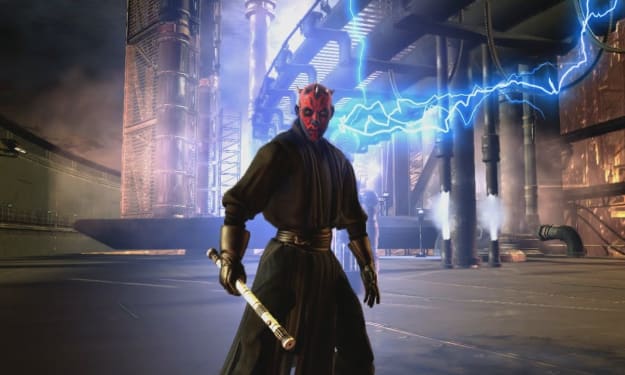

Comments
There are no comments for this story
Be the first to respond and start the conversation.